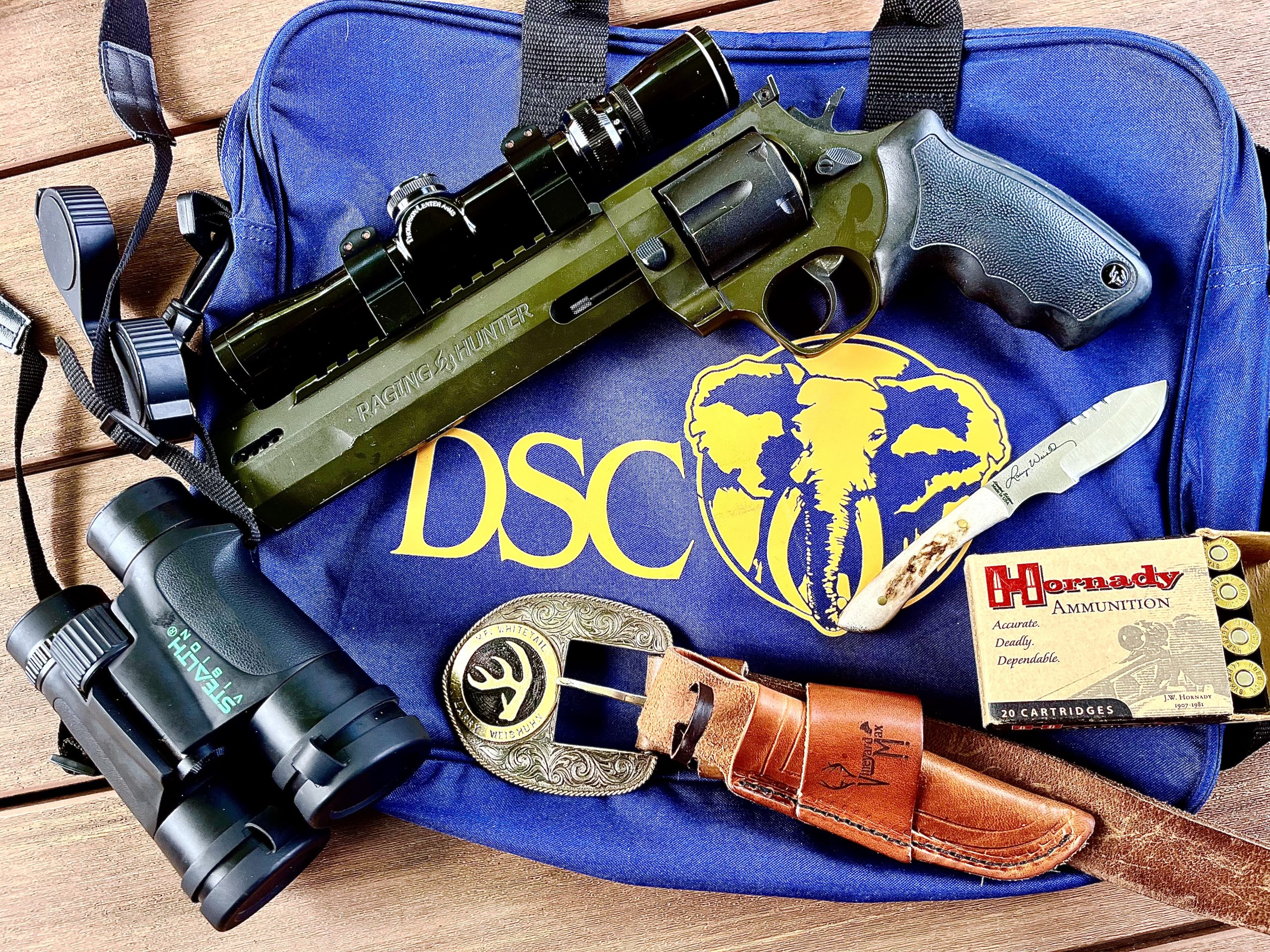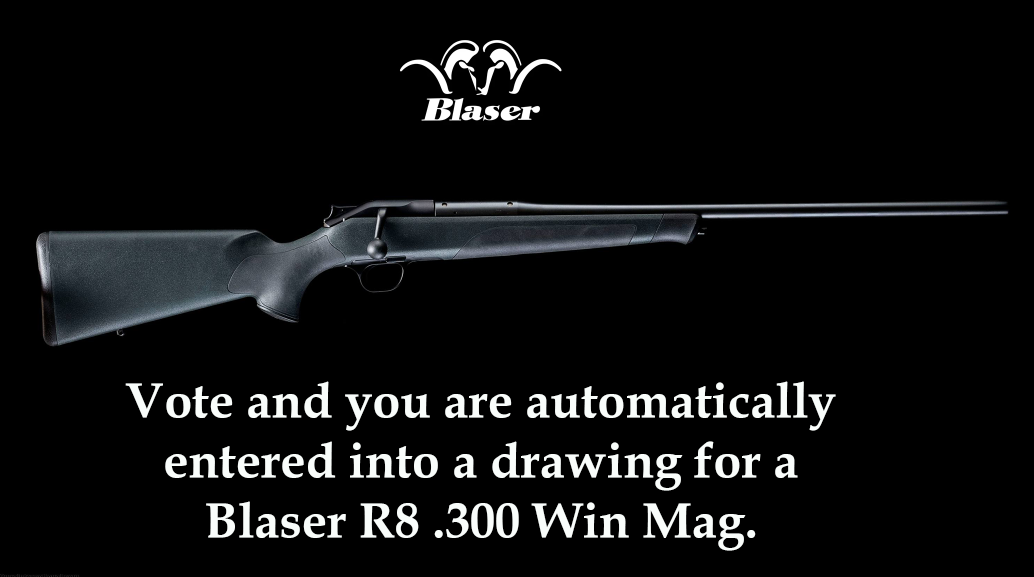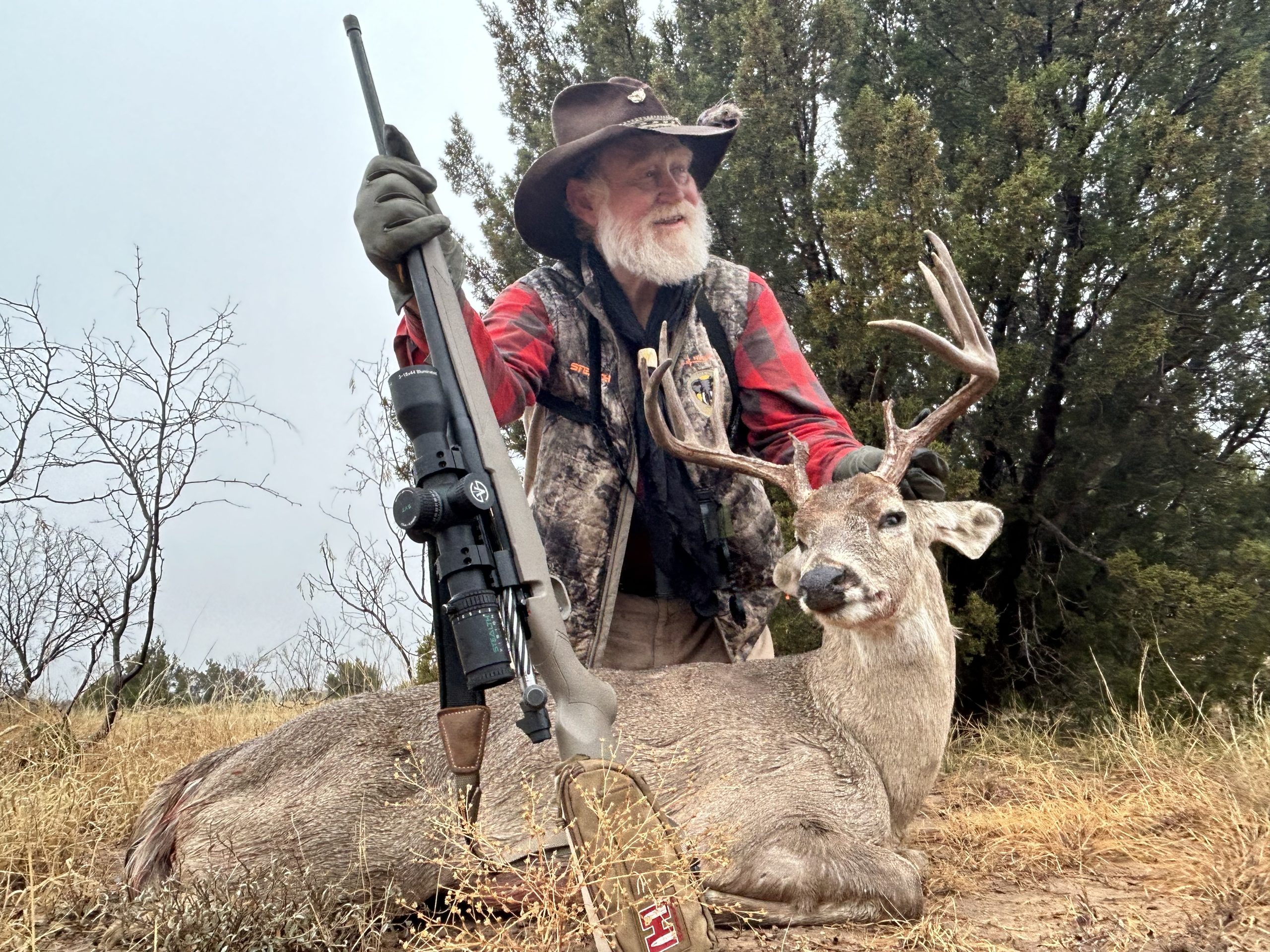“You ready?” I asked glancing over my right shoulder at the cameraman. He nodded an affirmative. I brought the two big double forked mule deer shed antlers together with a loud crack, followed immediately by meshing the tine together in a grinding manner. Three seconds later I caught movement running through the mesquite and cactus coming directly toward us. I kept rattling. I could see two bucks, including a very massive ten point, the other only a bit smaller racked. The smaller of the two sailed over a clump of prickly pear and landed about five yards in front of us. The bigger of the two tried to skirt around the cactus at a full run, lost his footing, fell on his side and nearly skidded into the shooting sticks I had set up right in front of me! Trying to regain his feet he kicked dirt and grass all over me.
Upright the bigger of the two bucks walked back and forth in front of us less than ten feet away. He was drooling, bug eyed, head held high with his ears laid back against his neck in a most aggressive manner! The smaller buck circled us.
The two bucks were truly performing for the camera, and for us. No doubt rattling season was at its prime! When the bucks started to walk away, I grunted and immediately they came back. Again they assumed aggressive postures. I was glad I had my Ruger .44 Mag Blackhawk at my side, just in case they decided to make good their threats!
The two started walking away again. This time I snort-wheezed (a fit,fit, feeeeeeeeeeeeee sound), the most aggressive vocalization a whitetail buck makes. Back they came.
I knew we were getting tremendous footage! After about five minutes of “messing with” those two bucks they walked away. This time I made no attempt to get them to return. I looked to my right. Another buck strode into one of my shooting lanes. This one was a basic ten point with several kicker points, obviously older than the two four year olds that just walked away. This buck cautiously moved downwind, another indication he was likely mature. When he walked from behind a thorny blackbrush, I could see his head, neck and shoulders. He too was drooling like the other two bucks and had the look of an old man with a swelled neck, complete with what looked like a “baggy” lower jaw line, and darkly stained hocks and tarsals, stained all the way to the “dew claws” just above his hooves. I knew he would not give me many chances or hang around too very long.
I have often said a big mature buck will give you no more than five seconds to see him, evaluate him in terms of antlers and age, estimate the distance and make the shot. I had already used up about four of those seconds….
“Don’t shoot, I’m not on him…” came the voice from behind me. I hesitated.
The buck turned and walked away. Moments later I saw him jump a bush, only his head and rack above the brush that hid him. Oh, well! So it goes!
Assured there were no other bucks responding. I turned to the cameraman. “That was a fabulous show. Did you see that buck fall and nearly slide into me? And that old multi-pointed buck…I really liked him, would loved to have taken him!” The cameraman was nodding. “Even though I didn’t shoot, that should make a great segment, or possibly be the opening of the show!”
I noticed the cameraman had gotten really quiet and had a sheepish look on his face. ‘Er..ah..ah..I’ve never seen anything like that in all my life!”
“Great!” I replied. “Now that we’ve got it on video you can look at it again and again!”
“Ah, er..ah.. I’M SORRY!” he blurted, “I got so excited I didn’t get any of It on camera. I was too enthralled with what was going on…..I didn’t press the record button!”
I really wanted to be mad and bad! But I simply started laughing, I knew crying wasn’t going to do any good. And scolding the cameraman wasn’t going to help. At least now he knew what could possibly happen when I started rattling!
It was back in the early 1960’s that I rattled up my first whitetail buck just a little way behind our home in rural Texas. I had read an article by Dan Klepper (then the outdoor writer for a San Antonio newspaper) in Field and Stream about hunting with Bob Ramsey a wildlife biologist in central Texas and how Ramsey rattled up bucks using shed antlers. I had also heard stories from my cousins who hunted the Brush Country of South Texas and how some of the vaqueros they hunted with in the “brasada” called in bucks making the sounds of two bucks fighting. I was convinced if they could do it, so could I. And I did! That first buck I learned later was a year-old buck, a fork horn. I rattled him in during October, before the deer season opened, but that’s when bucks in our area of Texas rutted. I was thrilled and knew I wanted to do it again!
Over the years I have done it again and more than just a few times, not only in Texas but throughout the whitetail deer range in North America!
To me, having bucks respond to “rattling horns” is by far the most exciting and satisfying way to hunt whitetail deer!
About three years ago I started using “Rattling Forks”, synthetic rattling tools developed by Steven Ray from near Austin, Texas. Steven is a truly dedicated whitetail hunter who is innovative and inventive! He developed “Rattling Forks” so you can make a lot of noise in a loud manner or simply tickle the two forks (build like massive antlers of a forkhorn buck) together to make a little noise. Steven, like I did, years ago learned that if bucks cannot hear the sound of two bucks fighting, they won’t respond!
For years I used real whitetail and mule deer antlers, sheds primarily, when rattling. But when I heard the sound of Steven Ray’s Rattling Forks (www.rattlingforks.com), I quickly made the switch.
Rattling works wherever whitetail deer exist. It works better where there are a lot of bucks. If you have a buck to doe ratio of 1 buck to 1 doe to 3 does in the population there are more bucks than if there is a buck to doe ratio of 1 buck to 10 or more does. So when you rattle there is a better chance one or more bucks will hear the fighting sounds when you have a narrower buck to doe ratio.
The best time to rattle in terms of season is right before the rut really kicks in. By then bucks have a high level of testosterone and are anxiously looking for a does and a fight! Once the rut fully kicks in bucks will still respond but they may be anxiously following does, rather than looking for a fight.
Over the past many years I’ve learned some bucks will respond to rattling horns pretty much any time once you see the first scrapes and do so until the time they cast their antlers.
As to the time of day to rattle….I rattle off and on throughout the day from first light to last light. Some times bucks respond better in the morning, sometimes better in the middle of the day and sometimes during the afternoon. But if you don’t try rattling just about every hour of the day you may not have anything respond. I learned this numerous years ago.
I was hunting a fabulous bit of South Texas just north of the Rio Grande. I had a friend drop me at the bottom of the property twelve miles from camp. My intention was to rattle and hunt my way back to camp. It was early December, bucks were active. It was cold for South Texas, and there was a slight breeze blowing from the north. I hunted into the wind, stopping about every 300 or so yards and rattling, watching downwind, knowing that’s where mature bucks would generally appear. The ranch had an excellent deer population and a very narrow buck to doe ratio. The helicopter game survey I had conducted in later October showed forty percent of the bucks were at least four years old and older!
From first light until just shy of eleven, I rattled eight different times and locations, staying at least twenty minutes after I quit rattling before moving on. Sometime the really old and big antlered bucks come in a bit after you finish your sequence. During those eight attempts, I had rattled in one coyote and one bobcat! Then from eleven o’clock until just shy of three o’clock, during six rattling sessions I rattled in thirty-two bucks! These ranged in age from yearlings to several which were five and six years olds. Out of those thirty-two bucks at least eight were certainly shooters.
From three o’clock till dark, I did not rattle in another buck!
The next day I had my friend drop me off again at the river about a mile farther west than the day before. I hunted and rattled my way north. The temperature was the same, wind direction and velocity the same, barometric pressure was the same also. Essentially weather conditions were exactly as the day before.
At first light I rattled in six bucks, all youngsters. An hour later I had three respond, two yearling and what looked like a three-year old. I did not rattle up another buck until just before dark, a really nice typical ten point.
If you decide to rattle where you hunt, don’t just rattle once or twice and then if it doesn’t work give up. Keep trying throughout the day!
How long I rattle during a sequence depends on how bucks respond or don’t respond. I may start out rattling fifteen to twenty seconds and then waiting a minute or so to rattle again. If that doesn’t bring in bucks, I rattle continually for several minutes. Once I find a sequence or timing bucks respond to, I’ll repeat it again and again, until they no longer respond to that particular sequence. Then I’ll change.
I dearly love hunting larger properties where I can do a fair amount of moving. But even if I can I’ll stay at one spot at least twenty to thirty or more minutes before moving.
Too, I’ve learned some days, bucks simply may not respond to rattling. Why? I have no idea, same as I have no idea why bucks respond differently each day as described earlier. But, I know that’s the case. So I adjust accordingly. And that too is why I carry my Convergent Hunting Solutions’ Bullet HP these days when rattling. Not only does the call have grunt and snort wheeze sounds on it, it also has a rattling sequence I did, as well as many other sounds that will attract coyotes and bobcats. If the bucks are not coming to horns, I can quickly switch to calling and hunting coyotes.
The other “tool” I carry is the Nature Blinds shield which provides a perfect hunting blind no matter where I hunt! It also serves as a good solid rest for my Ruger rifle and handgun, loaded with Hornady ammo.
These days my two favorite guns to use for rattling are the Ruger Guide Rifle in .375 Ruger, same one I use in Africa and elsewhere. I love the accuracy, short barrel and fast handling of the rifle. Loaded with Hornady 250 grain GMX or even 300 grain DGX it performs perfectly on whitetails as well as dangerous game. M favorite handgun is my old Ruger Super Blackhawk Hunter in .44 Mag, loaded with Hornady’s 240 grain XTP ammo. Like the Guide Rifle it handles very nicely and is extremely accurate!
it may be approaching summer time, but I am thinking about the upcoming whitetail season. And I know of a couple of places where I intend to rattle in a whitetail buck this coming fall. Big mature whitetail bucks generally approach from downwind, that’s a fact! And, it does no good to rattle in a buck and not see him. So I am headed to the property to set up some rattling “stands”, cutting shooting lanes. I’ll rattle those spots when the wind is out of the north…so I am cutting shooting lanes to the southeast and southwest of where I will be setting up. That way when that old buck moves to get directly downwind of where I’ll be rattling, I will be able to see him and get a shot before he gets directly downwind.
There’s one buck in particular I’m hunting for this fall. I saw him briefly last December. Just in case I do get him and I certainly intend to, I’m moving some of my mounts around so he’ll have a place of honor once I send him to and he returns from The Wildlife Gallery!



